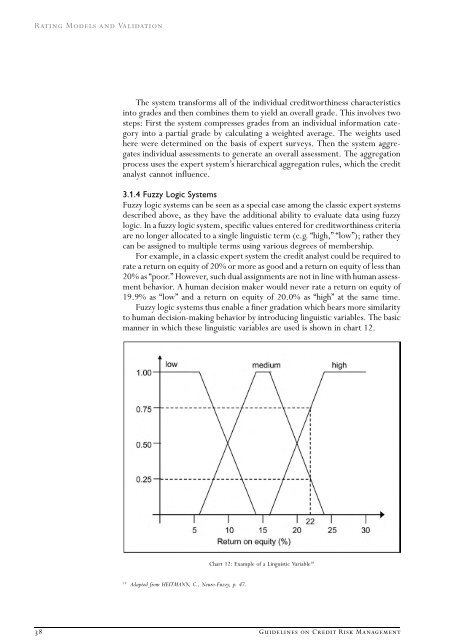Rating Models and Validation - Oesterreichische Nationalbank
Rating Models and Validation - Oesterreichische Nationalbank
Rating Models and Validation - Oesterreichische Nationalbank
Create successful ePaper yourself
Turn your PDF publications into a flip-book with our unique Google optimized e-Paper software.
<strong>Rating</strong> <strong>Models</strong> <strong>and</strong> <strong>Validation</strong><br />
The system transforms all of the individual creditworthiness characteristics<br />
into grades <strong>and</strong> then combines them to yield an overall grade. This involves two<br />
steps: First the system compresses grades from an individual information category<br />
into a partial grade by calculating a weighted average. The weights used<br />
here were determined on the basis of expert surveys. Then the system aggregates<br />
individual assessments to generate an overall assessment. The aggregation<br />
process uses the expert systemÕs hierarchical aggregation rules, which the credit<br />
analyst cannot influence.<br />
3.1.4 Fuzzy Logic Systems<br />
Fuzzy logic systems can be seen as a special case among the classic expert systems<br />
described above, as they have the additional ability to evaluate data using fuzzy<br />
logic. In a fuzzy logic system, specific values entered for creditworthiness criteria<br />
are no longer allocated to a single linguistic term (e.g. Òhigh,Ó ÒlowÓ); rather they<br />
can be assigned to multiple terms using various degrees of membership.<br />
For example, in a classic expert system the credit analyst could be required to<br />
rate a return on equity of 20% or more as good <strong>and</strong> a return on equity of less than<br />
20% as Òpoor.Ó However, such dual assignments are not in line with human assessment<br />
behavior. A human decision maker would never rate a return on equity of<br />
19.9% as ÒlowÓ <strong>and</strong> a return on equity of 20.0% as ÒhighÓ at the same time.<br />
Fuzzy logic systems thus enable a finer gradation which bears more similarity<br />
to human decision-making behavior by introducing linguistic variables. The basic<br />
manner in which these linguistic variables are used is shown in chart 12.<br />
18 Adapted from HEITMANN, C., Neuro-Fuzzy, p. 47.<br />
Chart 12: Example of a Linguistic Variable 18<br />
38 Guidelines on Credit Risk Management

















